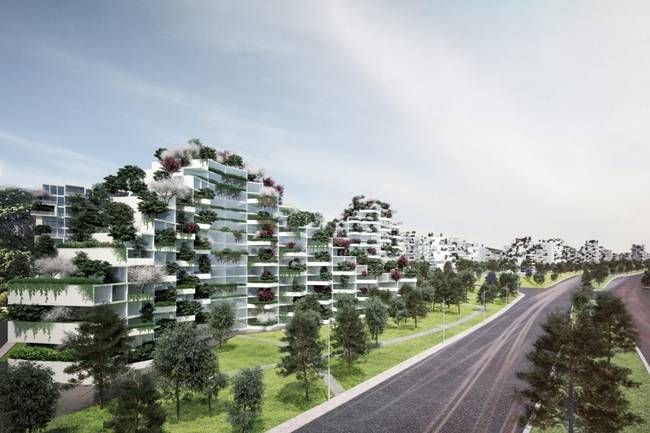By Tom McGregor, CCTV.com Panview commentator and editor
China continues to struggle with smog in large parts of the nation. The country's rapid economic rise has helped hundreds of millions of Chinese escape poverty, but the boom times have caused a significant deterioration in air quality.
Beijing hopes to clear the air and improve environmental standards, but making necessary changes will take many years and if the reforms introduced are too sweeping that could hinder economic development.
The process to transform China into a country that is green and clean will likely advance step-by-step with a series of progressive measures.
The strategy appears to be to shift energy consumption away from fossil fuels and towards renewable, closing down heavy-polluting factories and encourage the Chinese to pursue eco-friendly living standards.
To move forward on the agenda, Stefano Boeri Architetti, a Milan-based architect, has drawn up a plan to build a 'Forest City' in Liuzhou, Guangxi Province.

Surrounded by green
Developers of 'Forest City' just started construction, which is scheduled for completion in 2020. The Luizhou Municipality Urban Planning department had commissioned the project to be built on 175 hectares of land north of Luijiang River.
Boeri has designed a city that will be blanketed in a sea of greenery to reduce pollution and to inspire other Chinese developers to copy-cat his approach.
Luizhou's 'Forest City' is expected to have 30,000 residents, living in building complexes that are covered by plants, shrubs and trees.
The green buildings are known as "vertical forests," which first opened up in Milan and other towers of green now under construction in Laussane, Switzerland and Nanjing, China.
'Forest City' will be home to more than a million plants (100+ species), 2,500 shrubs and 40,000 trees. All commercial, leisure and residential facilities will be powered by geo-thermal and solar energy.
Eco-benefits
According to the website, Inhabitat, 'Forest City' will make a direct impact to cut down pollution in the region. The greenery can absorb nearly 10 tons of carbon dioxide per year, as well as 57 tons of pollutants.
In a press release written by Boeri:
"The diffusion of plants, not only in the parks and gardens or along the streets, but also over building facades, will allow the energy self-sufficient city to contribute to improve the air quality, to decrease average air temperatures, to create noise barriers and boost the biodiversity of living species, generating the habitat for birds, insects and small animals that inhabit Liuzhou territory.“
All 100-200 buildings are expected to be covered in plants and trees. That‘s no easy task and requires an abundant water supply and innovative technologies to help plants grow on a hard-surfaced complex.
Set in premier spot
The city is located deep in southern China, which enjoys a near tropical climate with plenty of rainfall and sunshine. It's rare for Luizhou to experience freezing weather.
People, who choose to live in 'Forest City,' can look out their windows to view idyllic scenery. The Karst Mountains and caves are set as a stunning backdrop for them.
Luizhou sits atop vast reserves of geo-thermal energy stored deep below the ground's surface. Accordingly, to live in 'Forest City' means to become one with nature.
Capping the residential population to 30,000 residents can ease transportation congestion, offer more living spaces for families and inspire other cities in China to designate zoning to construct more forest cities in the future.
Boeri intends to build both residential and commercial complexes. Two schools and a hospital are under construction as well. 'Forest City' is just like a regular town but the main difference: Trees and plants will cover all human-made surfaces.
Rail line rolls in
'Forest City’ will be set apart from the Luizhou business district and residents, who support carbon-free lifestyles, are likely to avoid driving gas-guzzling vehicles.
City planners will build a hi-speed electric rail line to connect commuters. The Luizhou Electric Rail Line will have solar panels on the exterior and utilize geo-thermal energy for air-conditioning in the train.
The public transportation is not only green-friendly, but will ease roadside traffic congestion. The rail line can serve as a pilot-project should other Chinese cities propose to build new forest cities.
For tomorrow's generation
'Forest City' will not cure China of all its pollution ills, but Beoeri believes the initiative will lead to stronger support for eco-friendly development in the nation.
In a press release, Boeri wrote 'Forest City' should inspire a "new generation (of forest cities), capable of becoming a model of sustainable growth in such a large country."
He added, "It is positive because the presence of such a large number of plants, trees and shrubs is contributing to the cleaning of the air, contributing to absorbing CO2 and producing oxygen. And what is so important is that this large presence of plants is an amazing contribution in terms of dust produced by urban traffic."
Boeri harbors a daring dream to see more forest cities emerge. He's already designing new plans for another forest city in Shijiazhuang, Hebei Province -northern China.
The Forest City sounds brilliant and one wonders why it hasn’t been attempted before.
(The opinions expressed here do not necessarily reflect the opinions of Panview or CCTV.com)

Panview offers a new window of understanding the world as well as China through the views, opinions, and analysis of experts. We also welcome outside submissions, so feel free to send in your own editorials to "globalopinion@vip.cntv.cn" for consideration.
















